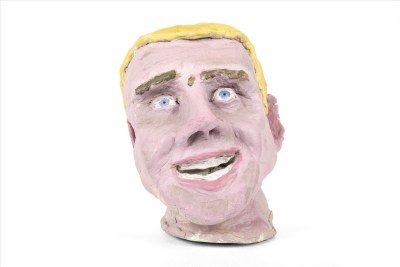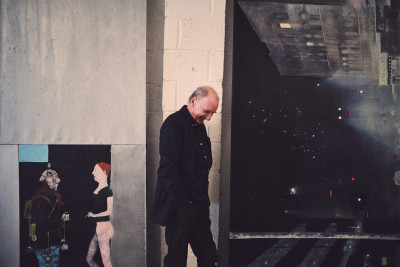Conrad Shawcross: “For the first time I see the political potential in my work”
Conrad Shawcross: “For the first time I see the political potential in my work”
As I see it
By Louise Cohen
Published 28 June 2017
With his new 16-metre installation suspended above commuters at St Pancras International, London-born sculptor Conrad Shawcross talks activism, optical illusions and why he likes a bit of trapeze.
-
My parents are writers
and my step-father a painter, so I grew up with quite creative conversations and ideas around happening me. I was always making things in my bedroom and taking things apart.
I learned to sail as a kid
and it was a really influential thing in my life. Just the simplicity of being in an old wooden sailboat, a modest thing, and the dynamic of the wind and the mast and the water… It’s such an escape. It’s a very spiritual thing to do.
My advice? Don’t be a barman.
You’re totally bombarded by people asking you things, and you get no headspace. If you’re an artist and you have to work in your spare time, do something menial, like sweeping a floor, and then you can use the time to plan or dream. I used to work as an extra in films, so I could retreat into my own head when I was dressed as a Roman soldier or whatever, standing there for eight hours.
I wouldn’t have been a very good scientist.
I’m trying to give my works an appearance of scientific rationality, but I tend to have quite an emotional or instinctive reaction to an idea, that’s not necessarily a correct understanding of it. I like the idea that my works are sort of like failed models; they ask questions rather than answer them.
-
Conrad Shawcross on the making of his St. Pancras installation
We visited the artist in his studio for a behind-the-scenes look at how he made The Interpretation of Movement (a 9:8 in blue).
-
The St. Pancras piece is my biggest mechanical work.
It’s 16 metres in diameter and weighs three and a half tonnes. Three primary arms rotates clockwise, and they have secondary and tertiary arms which slowly rotate in and out from the centre. It’s nice that it’s in Kings Cross too; I grew up in Camden and my sculpture Paradigm is just next door, outside the Francis Crick Institute.
Public art is challenging.
This work is a massive and vastly complicated machine that will be moving above people’s heads – and a railway station is by far and away the most safety-conscious place I’ve worked in. It’s another challenge to relish.
I can’t control the meaning of a work once I’ve made it.
And if I could it wouldn’t be an artwork. It has to live beyond what I intended it to mean, and the more it’s interpreted in unpredictable ways, the more successful it is.
Optics fascinate me.
For over two years I researched this sort of psychedelic visual phenomenon called the Moiré effect. The Optic Cloak was a big cladding for a chimney I did in Greenwich, that allows the light to pass through it, so when the sun is behind it, it kind of awakens the optic sensors in your eyes and you see this sort of shimmer. It seemed to me that this phenomenon hadn’t been exploited enough, and I wanted to find the sweet spot where it happens. I suppose the St Pancras project splices that research with interests from my older work – ratios and movement and time.
For the first time I see the political potential in my work
– as this abstract machine of mine hangs over the future border between the EU and the UK. There’s a big glass wall underneath my sculpture in St. Pancras, which is going to become a much more significant division as Brexit progresses. I don’t know how that will affect the meaning of the work.
-

Conrad Shawcross, The Optic Cloak, 2016.

Conrad Shawcross, Paradigm.

Conrad Shawcross, The Dappled Light of the Sun, 2015.

Conrad Shawcross, Monolith (Optic), 2016.
-
Brexit means bureaucracy.
I’ve been talking about this at our studio lunches a lot recently. The amount of onerous forms that will be imposed on the individual through Brexit is going to be far greater than anyone imagines. It’s not going to be the utopia the libertarian right dream of because, for all its faults, the EU emancipated the individual from the tyranny of bureaucracy. It’s currently unbelievably simple for people to move here and there, to put their kids into school, to go to work and save a life in a hospital. My wife is Italian, our son European. My step-kids are Italian and go to a local school here. They may no longer be eligible for a place having been here for three years. Who knows how the new rules will be implemented, but it’s going to be vastly complex and time-consuming. The freedom of movement is the most beautiful of ideas.
My generation needs to get involved.
When we left university, me and my friends didn’t go into politics – it didn’t feel as though there was any need to fight against the system. There is a need now. Democracy is weak and my parents’ generation are at the point of retirement.
The planet is under pressure
with population and climate change and war and famine – but we’re not anywhere near the point where we need to start abandoning our principles. When Trump was questioned on the news about the use of torture in fighting terrorism, I was shocked that the entire debate was about whether it was effective or not. Not a single news presenter actually mentioned the fact that it was wrong – that this was a demeaning, degrading and immoral thing for a society to do. We need to stand together on that.
You don’t have to be responsible for the world as an artist.
Being an artist can be whatever you want it to be. You can be a hermit and paint all your life and never go out and see the light of day if you want to. It’s totally your own privilege how you decide to be an artist.
-
I used to work as an extra in films. I would retreat into my own head when I was dressed as a Roman soldier, standing there for eight hours.
-
I do a bit of trapeze from time to time.
I started in my early 20s, when I was looking for a sport. I thought maybe I could become a professional trapeze artist but I’m not quite good enough. It’s very good for your back, stretches you out – especially when someone’s hanging from your arms and you’re dangling from your knees. I have a trapeze at home so I’m training my son.
My studio used to be a stable for horses.
They pulled the 38 bus. And then it was a taxidermist’s. And then it was a sheet metal bending factory… Until 2007 when I bought it. I lived in it, this derelict Victorian shed, for about eight years before we developed it into a purpose-built studio. I was very lucky to find it back then, when people called it Murder Mile. Now London is very problematic for young artists. I’ve got lots of issues with my staff who are all artists – they’re all moving to Margate where it’s more affordable.
I fought hard to get here
but you can become a bit detached from how hard it is as a young artist. You forget how ruinous it was to have to work five days a week to pay your exorbitant rent, and then be so exhausted you didn’t go and use your studio. But ten years ago I was doing exactly that.
It’s a bit embarrassing being the youngest Royal Academician.
I mean, it’s been lovely, but I’m 40 now. I think it’s really about time that we got some younger people in. I’m ready to hand over the baton.
-
Inside Conrad Shawcross's studio

Sketchbook pages full of notes and diagrams

A boat in progress, outside the main studio

View from the studio mezzanine

Sculptures around the studio
-
The Interpretation of Movement (a 9:8 in blue) is at St. Pancras International. The new public installation marks the fifth year of the Terrace Wires commission at the station and the third in partnership with the Royal Academy.











